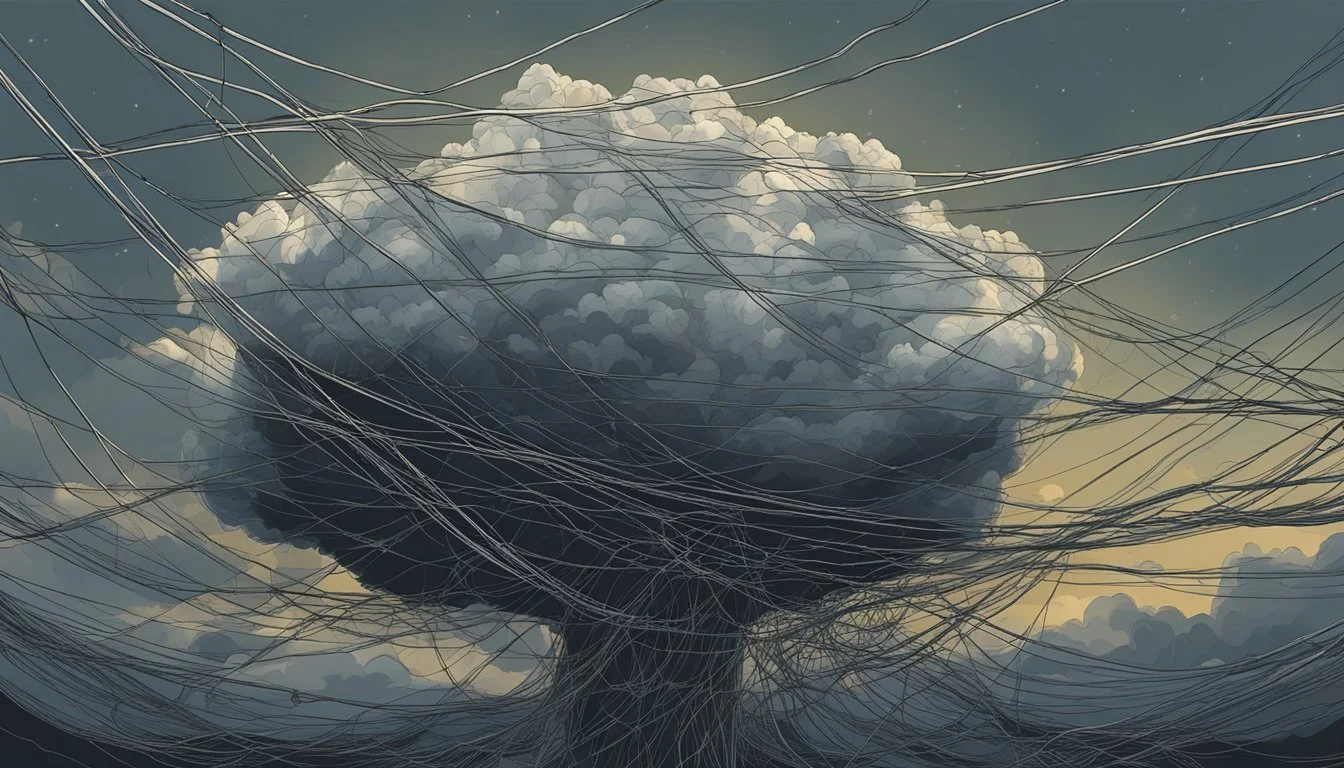Infinite Jest and Infinite Pain: David Foster Wallace's Literary Legacy and Mental Health Struggle
David Foster Wallace's magnum opus "Infinite Jest" delves deep into the human psyche, exploring themes of addiction, depression, and the search for meaning in a fractured world. The novel's portrayal of mental illness, particularly through characters like Kate Gompert, offers readers a raw and unflinching look at the devastating effects of depression.
Wallace's own struggles with depression informed his writing, lending an authenticity and depth to his depictions of mental anguish. His descriptions of suicidal thoughts and the overwhelming pain of depression resonate with many readers who have experienced similar struggles. The author's ability to articulate the often inexpressible nature of mental illness has made "Infinite Jest" a touchstone for those grappling with their own inner demons.
The novel's complex narrative structure and intricate web of characters mirror the chaotic and overwhelming nature of depression itself. Through his masterful prose, Wallace captures the relentless nature of mental illness and the ways it can consume every aspect of a person's life. "Infinite Jest" stands as a testament to Wallace's literary genius and his profound understanding of the human condition.
David Foster Wallace: An Insight into the Author's Life
David Foster Wallace grappled with mental health issues throughout his life while pursuing a prolific literary career. His personal struggles deeply influenced his writing, resulting in works that explored complex philosophical and emotional themes.
Struggles with Mental Health
Wallace battled severe depression from a young age. He sought treatment through various means, including therapy, medication, and hospitalization. In the 1980s, he began taking the antidepressant Nardil, which provided some relief.
Despite periods of stability, Wallace's depression remained a constant challenge. He underwent electroconvulsive therapy in an attempt to alleviate his symptoms. The author's mental health struggles profoundly impacted his personal life and creative output.
Wallace's experiences with depression informed his writing, particularly in "Infinite Jest," where he portrayed characters dealing with addiction and emotional pain.
Literary Career and Philosophy
Wallace's literary career began with the publication of "The Broom of the System" in 1987. His breakthrough came with "Infinite Jest" in 1996, a sprawling novel that cemented his reputation as a literary innovator.
His writing style combined dense prose, extensive footnotes, and complex narrative structures. Wallace explored themes of addiction, entertainment, and the human condition in his work.
The author's philosophical background, including his time studying at Harvard, influenced his approach to literature. He grappled with questions of meaning, communication, and the nature of reality in his fiction and essays.
The Intersection of Life and Work
Wallace's personal experiences deeply informed his writing. His struggles with mental health provided insight into the emotional landscapes of his characters.
The author's interest in philosophy and language manifested in his exploration of communication and meaning in works like "The Broom of the System."
Wallace's essays often drew from his own life, blending personal anecdotes with cultural criticism. His non-fiction showcased his ability to examine complex topics with clarity and depth.
The themes of loneliness, connection, and the search for authenticity in Wallace's work reflected his own inner turmoil and quest for understanding.
Infinite Jest: A Masterpiece of Contemporary Fiction
David Foster Wallace's Infinite Jest stands as a monumental achievement in contemporary American literature. The novel's complex narrative, intricate themes, and unforgettable characters have cemented its place as a defining work of postmodern fiction.
Synopsis and Themes
Set in a near-future North America, Infinite Jest weaves together multiple storylines centered around the Incandenza family, the Enfield Tennis Academy, and a halfway house for recovering addicts. The novel explores themes of addiction, entertainment, and the search for meaning in a hyper-commercialized world.
Key plot elements include:
The pursuit of a mysterious film rumored to be fatally entertaining
Hal Incandenza's struggles with substance abuse and competitive tennis
The machinations of wheelchair-bound Quebecois separatists
Wallace's keen observations on human nature and society are evident throughout, as he examines the complexities of family relationships, the nature of addiction, and the impact of technology on human connection.
Innovative Narrative Structure
Infinite Jest is renowned for its unconventional structure and experimental style. Wallace employs:
Nonlinear storytelling
Multiple narrators and perspectives
Extensive use of endnotes (some with their own footnotes)
Varied writing styles and formats
This complex structure mirrors the fragmented nature of modern life and challenges readers to actively engage with the text. The novel's temporal shifts and narrative threads create a rich tapestry that rewards careful reading and rereading.
Character Analysis and Symbolism
Wallace populates Infinite Jest with a diverse cast of characters, each serving as a lens through which to explore the novel's themes.
Notable characters include:
Hal Incandenza: A tennis prodigy struggling with addiction and identity
Joelle van Dyne: An actress and radio personality known as the "Prettiest Girl of All Time"
Don Gately: A recovering addict and staff member at Ennet House
Symbolism plays a crucial role in the novel. The titular "Infinite Jest" film represents the ultimate form of escapist entertainment, while the Enfield Tennis Academy serves as a microcosm of societal pressures and expectations.
Wallace's meticulous attention to detail in character development creates a vivid and immersive world that continues to captivate readers decades after its publication.
The Role of Entertainment and Addiction in Infinite Jest
David Foster Wallace's Infinite Jest explores the intertwining themes of entertainment and addiction in a dystopian America. The novel presents a world where media consumption and substance abuse dominate society, shaping characters' lives and struggles.
Media Satire and Cultural Commentary
Infinite Jest portrays a future where entertainment has become all-consuming. The novel's central plot device, a film so captivating it renders viewers catatonic, serves as a metaphor for society's insatiable appetite for distraction. Wallace critiques the entertainment industry's power to manipulate and control audiences.
The fictional "InterLace TelEntertainment" system represents a prescient vision of on-demand streaming services. This technology allows users to access endless content, mirroring modern concerns about digital addiction and information overload.
Wallace's satirical depiction of advertising and consumerism highlights how media shapes cultural values and behaviors. Characters obsess over brand names and commercial slogans, reflecting the pervasive influence of marketing in their lives.
Addiction's Impact on the Characters
Substance abuse plays a central role in Infinite Jest, with many characters struggling with drug and alcohol addiction. The novel explores how addiction affects relationships, personal growth, and societal structures.
Key characters like Don Gately and Hal Incandenza grapple with marijuana and other drug dependencies. Their struggles illustrate the physical and psychological toll of addiction, as well as its impact on family dynamics and personal identity.
Wallace draws parallels between substance addiction and compulsive entertainment consumption. Both are portrayed as attempts to escape reality and fill emotional voids, often leading to destructive consequences.
Recovery and Redemption Narratives
Infinite Jest presents recovery as a complex, ongoing process. The novel depicts Alcoholics Anonymous meetings and rehabilitation programs, highlighting the challenges and breakthroughs in overcoming addiction.
Don Gately's journey through AA serves as a central redemption narrative. His experiences illustrate the daily struggles of maintaining sobriety and the importance of community support in recovery.
The novel explores how characters confront their addictions and seek meaning beyond substance use or entertainment. This process often involves painful self-reflection and the difficult work of rebuilding relationships and personal identity.
Exploring Mental Illness and Emotional Isolation
David Foster Wallace's Infinite Jest depicts mental illness and emotional isolation with raw authenticity. The novel examines depression, anxiety, and psychotic episodes through vivid character portrayals.
Depictions of Depression and Anxiety
Wallace portrays depression as a pervasive, inescapable force. Characters like Kate Gompert struggle with intense emotional pain and anhedonia. The novel describes depression as a "nausea of the soul" - a visceral, all-consuming experience.
Anxiety manifests in various forms throughout the story. Hal Incandenza's fear of failure and perfectionism reflect common anxiety symptoms. The pressure to perform at the tennis academy creates a breeding ground for anxiety disorders.
Wallace's descriptions capture the physical sensations of panic attacks and intrusive thoughts. His writing style mirrors the racing, circular thinking patterns associated with anxiety.
Loneliness and the Search for Empathy
Emotional isolation is a central theme in Infinite Jest. Many characters feel profoundly alone despite being surrounded by others. The Ennet House residents exemplify this paradox - united by addiction yet isolated in their personal struggles.
Wallace explores the challenges of genuine human connection. Characters like Don Gately attempt to break through their isolation by participating in support groups and building relationships.
The novel suggests empathy as an antidote to loneliness. However, it also acknowledges the difficulty of truly understanding another's pain. Wallace's nuanced approach highlights both the necessity and limitations of empathy.
The Psychotic Depression Portrayal
Kate Gompert's experience with psychotic depression receives particular focus. Wallace describes her condition as a "black hole" of consciousness - a state beyond ordinary sadness or despair.
The novel details Kate's suicidal thoughts and hospitalizations. It explores the complex interplay between her depression, marijuana use, and psychotic symptoms. Wallace's portrayal emphasizes the overwhelming nature of psychotic depression.
Through Kate's character, the book examines the shortcomings of psychiatric treatment. It highlights the challenges of communicating such intense psychic pain to others, including medical professionals.
The Writing Style of David Foster Wallace
David Foster Wallace's distinctive writing style captivated readers with its complexity and depth. His works blended intricate narratives, experimental techniques, and profound insights into the human condition.
Use of Endnotes and Footnotes
Wallace's use of endnotes and footnotes became a hallmark of his writing. In "Infinite Jest," he employed over 300 endnotes, some spanning multiple pages. This technique allowed him to add layers of information and digressions without disrupting the main narrative.
The footnotes often contained crucial plot details, character backgrounds, or philosophical musings. They challenged readers to engage actively with the text, flipping back and forth between pages.
Wallace's footnotes also served as a meta-commentary on the nature of information overload in modern society. They mirrored the fragmented attention spans and constant distractions of the digital age.
Wallace's Literary Approach
Wallace's literary approach combined postmodern techniques with sincere emotional depth. He rejected the irony and detachment of earlier postmodernist writers, striving instead for authentic human connection.
His prose was dense, complex, and often challenging. Long, winding sentences packed with clauses and parentheticals reflected the chaotic nature of human thought.
Wallace incorporated elements of various genres, including satire, science fiction, and literary realism. He blended high and low culture references, creating a rich tapestry of ideas and allusions.
His writing often explored the tension between intellect and emotion, analyzing human experiences with both academic rigor and raw vulnerability.
Themes of Salvation and Self-Destruction
Salvation and self-destruction emerged as recurring themes in Wallace's work. He grappled with the human struggle for meaning and connection in a world of endless distractions and addictions.
In "Infinite Jest," characters sought salvation through various means - drugs, entertainment, athletics - often leading to self-destructive behavior. Wallace explored the paradox of seeking fulfillment through external sources.
His unfinished novel "The Pale King" delved into themes of boredom, attention, and the search for meaning in mundane work. It portrayed characters finding a form of salvation through intense focus and mindfulness.
Wallace's writing reflected his own battles with depression and addiction. He sought to illuminate paths to redemption while acknowledging the ever-present pull of self-destruction.
The Broader Impact of Infinite Jest
David Foster Wallace's magnum opus has left an indelible mark on literature and popular culture. Its influence extends far beyond the realm of fiction, touching on philosophy, science, and the human experience.
Influence on American Literature and Culture
Infinite Jest redefined postmodern literature with its encyclopedic scope and innovative narrative techniques. The novel's fragmented structure and extensive use of endnotes inspired a new generation of writers to experiment with form and content.
Its exploration of addiction, entertainment, and technology proved prescient, anticipating many of the cultural issues that would dominate the 21st century. The term "Infinite Jest" itself has entered the lexicon as shorthand for excessive entertainment and distraction.
Wallace's unique prose style, blending erudition with vernacular speech, has influenced countless authors and reshaped the landscape of American fiction.
Science Fiction Elements and Cynicism
While not strictly science fiction, Infinite Jest incorporates futuristic elements that serve as vehicles for social commentary. The novel's vision of a hyper-commercialized North America, where years are subsidized by corporations, reflects a cynical view of consumer culture.
The Entertainments, especially the lethally addictive film "Infinite Jest," serve as a metaphor for the dangers of passive consumption. This blend of science fiction and satire creates a powerful critique of modern society.
Wallace's portrayal of technology's impact on human relationships and communication remains relevant in today's digital age, highlighting the enduring nature of his observations.
Exploration of the Human Condition
At its core, Infinite Jest is a profound examination of the human condition. The novel delves into themes of addiction, depression, and the search for meaning in a world dominated by entertainment and distraction.
Wallace's characters grapple with existential questions, struggling to find authentic connections in a society that often feels isolating and artificial. The novel's treatment of mental health issues, particularly depression, has been lauded for its accuracy and empathy.
Through its diverse cast and intricate plotlines, Infinite Jest offers a multifaceted view of human experience, challenging readers to confront uncomfortable truths about themselves and society.
Adaptations and Cultural References
David Foster Wallace's "Infinite Jest" has inspired various adaptations and cultural references, extending its influence beyond literature. The novel's impact spans films, performances, and other media.
The End of the Tour and Jesse Eisenberg's Portrayal
"The End of the Tour" (2015) brought Wallace's life to the big screen. The film depicts a five-day interview between Wallace and Rolling Stone reporter David Lipsky. Jesse Eisenberg portrays Lipsky, while Jason Segel takes on the role of Wallace.
Segel's performance garnered critical acclaim for its nuanced depiction of Wallace's complex personality. The film explores themes of fame, depression, and the writing process, offering insights into Wallace's mindset during the "Infinite Jest" book tour.
Legacy and References in Other Media
"Infinite Jest" has left an indelible mark on popular culture. The novel's themes and concepts have been referenced in TV shows like "Parks and Recreation" and "The Good Place."
Musicians have also drawn inspiration from Wallace's work. The Decemberists' song "Calamity Song" features a music video based on the novel's Eschaton game. Visual artists have created works inspired by the book's intricate plot and characters.
Academic conferences and reading groups dedicated to "Infinite Jest" continue to analyze its lasting impact on literature and society.
David Foster Wallace's Exploration of Self-Consciousness
David Foster Wallace grappled extensively with self-consciousness in his writing. His works delve into the complexities of human perception and the influence of religious and philosophical ideas on self-awareness.
Perception of Self and Others
Wallace's characters often struggle with intense self-consciousness. In "Infinite Jest," he portrays individuals hyper-aware of how others perceive them. This awareness leads to social anxiety and feelings of alienation.
Wallace explores the notion of "analysis paralysis" - overthinking to the point of inaction. His characters frequently dissect their own thoughts and behaviors in excruciating detail.
The author also examines how self-consciousness impacts relationships. Many of his characters struggle to connect authentically with others due to their preoccupation with self-image.
Wallace's Religious and Philosophical Views
Wallace's upbringing in a Catholic household influenced his exploration of self-consciousness. He often incorporated religious themes into his work, questioning the role of faith in shaping one's sense of self.
His writing reflects a deep interest in philosophy, particularly the ideas of Ludwig Wittgenstein. Wallace used these concepts to examine how language shapes consciousness and self-perception.
The author grappled with the concept of anomie - a state of normlessness in society. He explored how this societal condition affects individual self-awareness and contributes to feelings of isolation.
Wallace's work often questions the authenticity of the self in a media-saturated culture. He examines how external influences shape identity and self-perception in the modern world.





